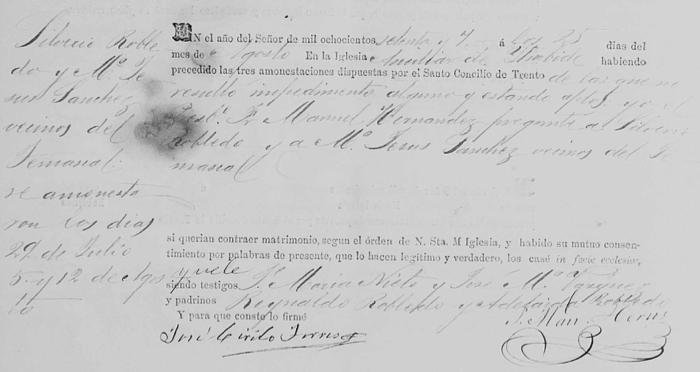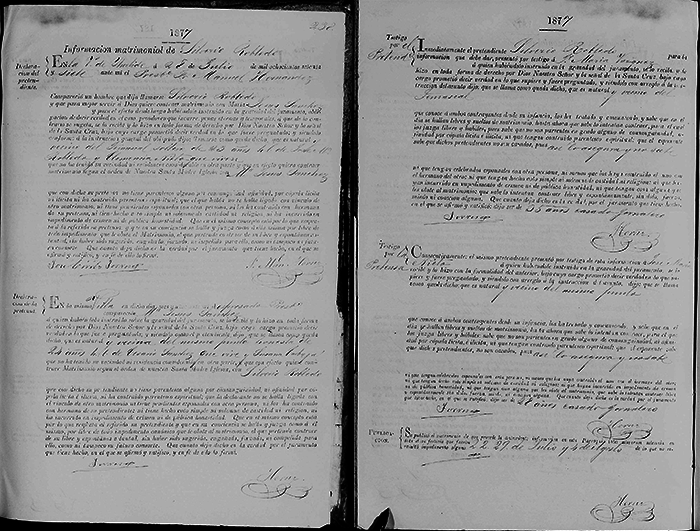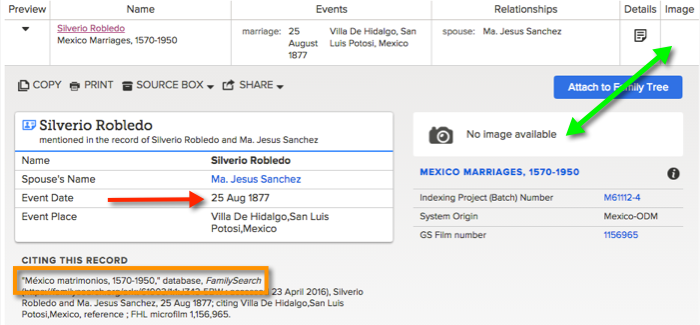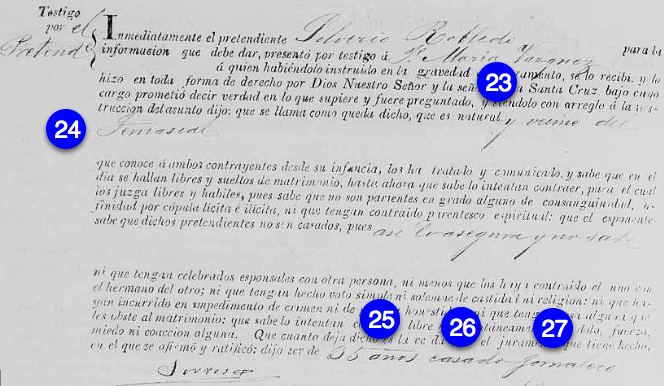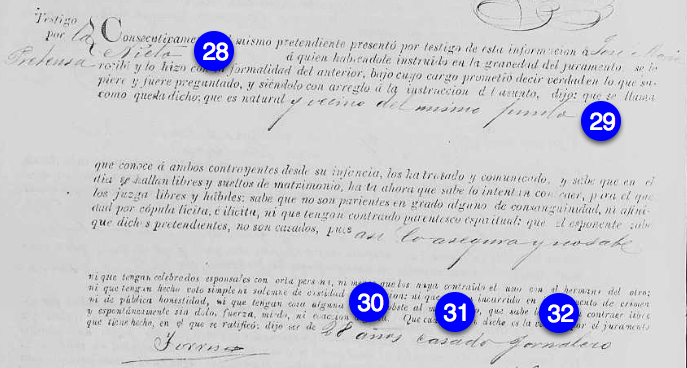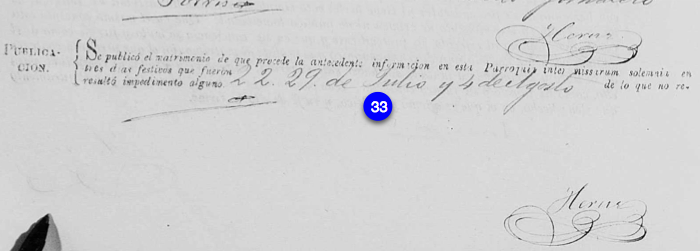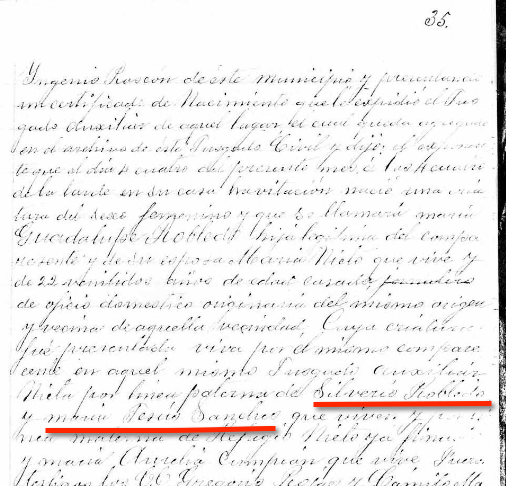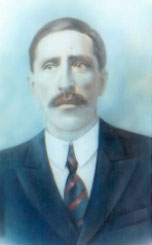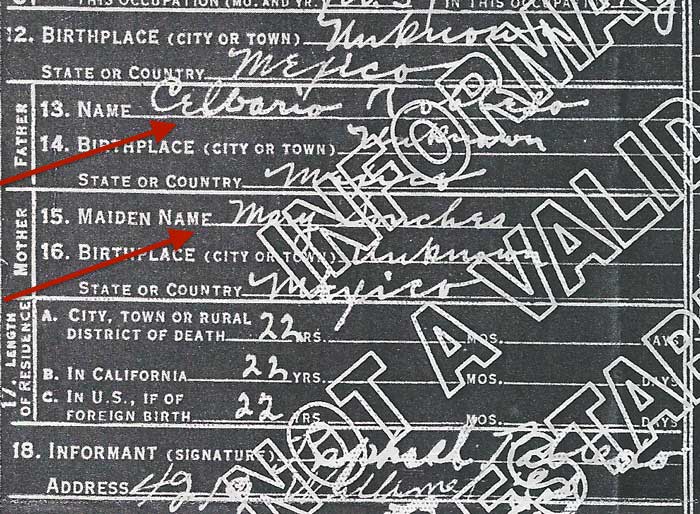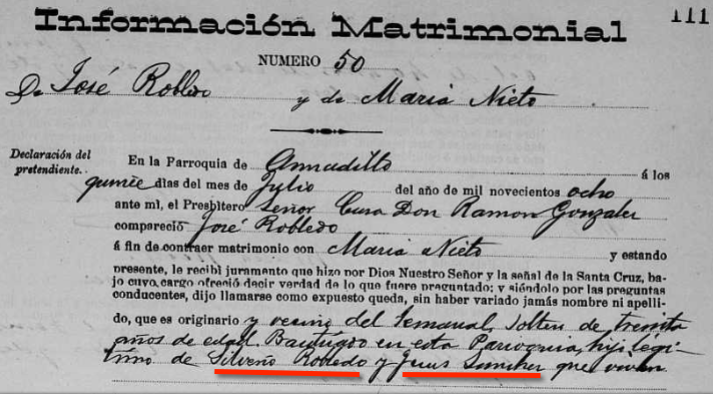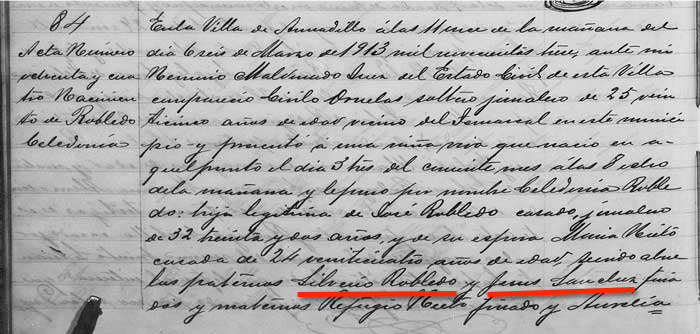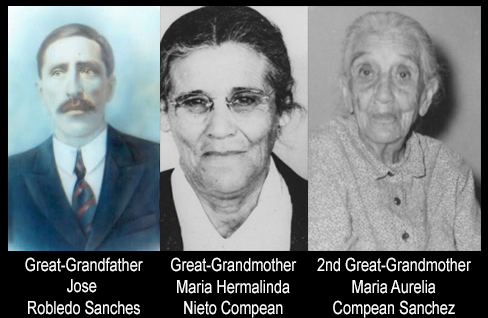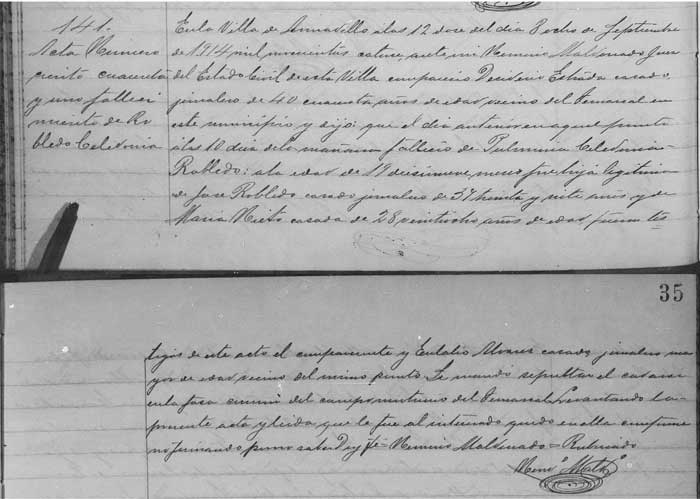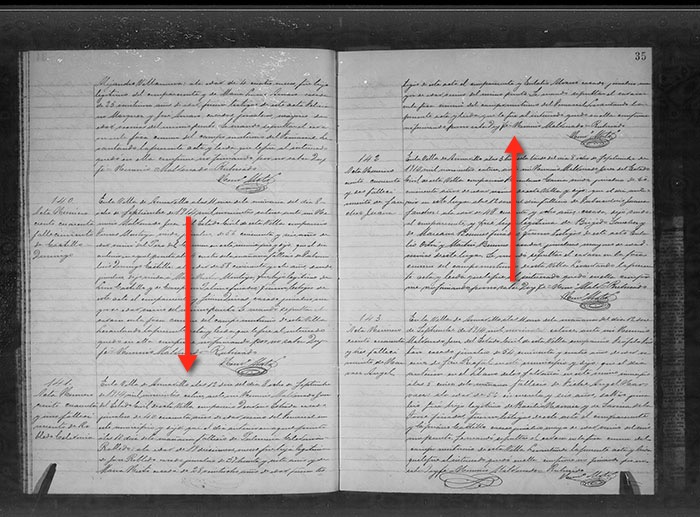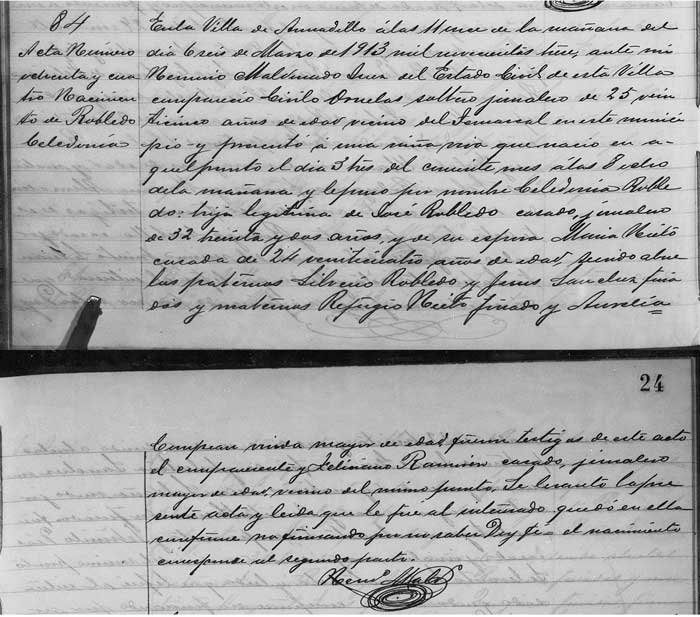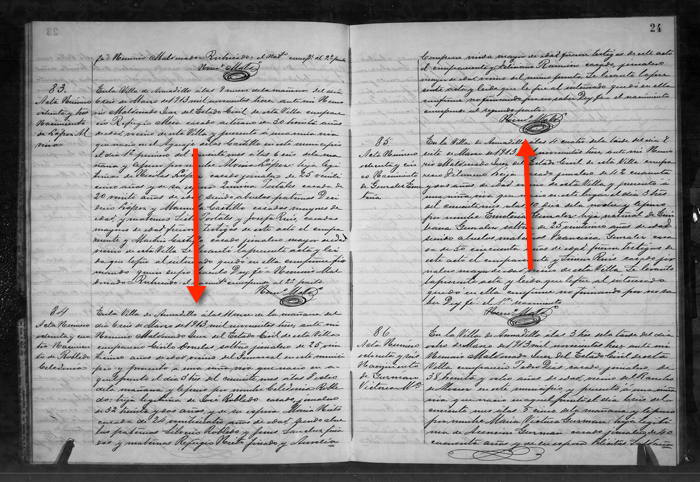My great-grandparents and their ancestors lived for centuries in the Armadillo and Villa Hidalgo area of the state of San Luis Potosí in central Mexico. Most of their births, baptisms, marriages, deaths, and burials took place in these two present-day municipios (similar to counties) and accompanying parishes, or within what now amounts to a one hour driving radius. This ancestral home region is dry arid ranching and farming country.
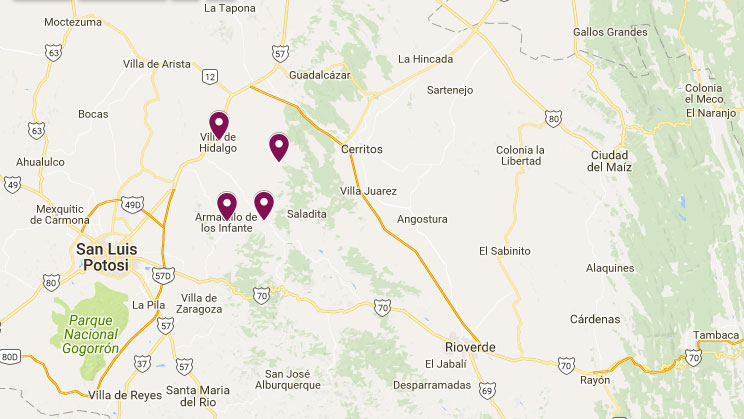
Looking for Great-Aunt Lupe
One particular record has stuck out in my mind since discovering it in late 2015 when Ancestry released its indexed Mexican civil registration collection—the 1910 birth registration for my great-aunt Lupe Robledo, who I knew as a very young child. Maria Guadalupe “Lupe” Robledo Nieto (1910-1975) was the oldest child of my immigrant great-grandparents, José Pablo Robledo Sanches (1879-1937) and Maria Hermalinda Nieto Compean (1887-1973). According to her civil birth registration, Lupe was born 4 July 1910 in her parents’ home.1 But that home was not at all where I suspected.
I had looked several years for a birth or baptism record for Lupe to no avail, until Ancestry released that indexed civil registration collection in October 2015. My hunt had been focusing on the municipios and parishes of my ancestors’ traditional homelands for centuries. But Lupe was not born in that part of the state—the same part of the state in which her parents married 2 years prior to her birth.
The newly released indexed civil birth registration collection was literally searchable for the first time, and a quick search for children born to my great-grandparents revealed that Aunt Lupe had been born outside of our ancestral region. She had been born 155 miles southeast of the family home, in a place identified on her birth record as Yngenio Rascon, located in the muncipio of San Nicolás de los Montes (now in the muncipio of Tamosopo), still in the state of San Luis Potosí.2
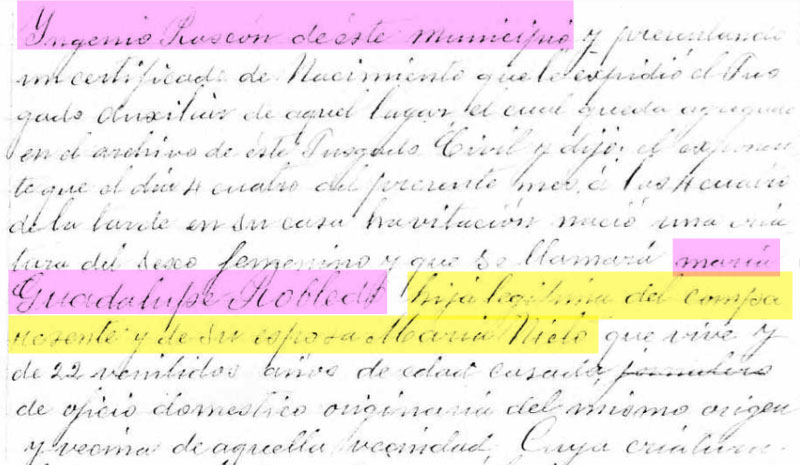
“San Luis Potosi, Mexico, Civil Registration Births, 1860–1947,” entry for Guadalupe Robledo, 21 July 1910 [born 4 July 1910]; database with digital images, Ancestry (http://search.ancestry.com : accessed 19 November 2015; citing Registro Civil [Civil Registration] del Estado [state] de San Luis Potosí, México; San Nicolás de los Montes, 1909–1912; 1910, folio 3 front.
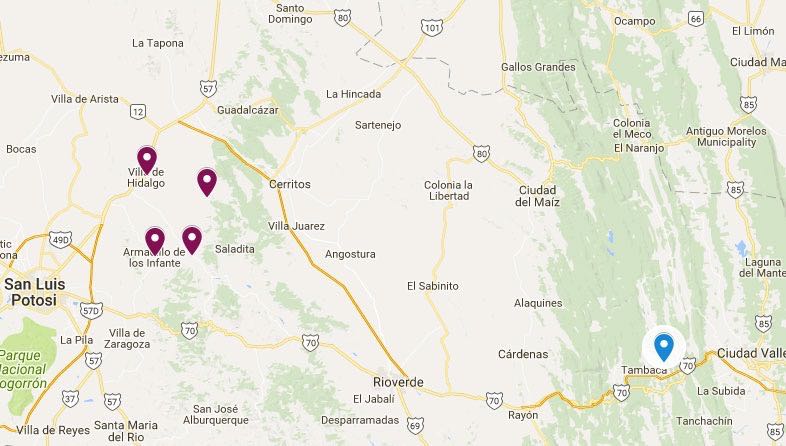
Yngenio Rascon: What & Why?
Not being familiar with the term Yngenio (also spelled Ingenio), I turned to Google Translate and learned that in this context yngenio refers to a plant, like a manufacturing plant. A little more time searching via Google told me that this was (maybe it still is?) a sugar manufacturing plant.
This was starting to make sense now. The birth and baptism records for his Mexico-born children tell me that my great-grandfather José was a farmer/farm laborer. It is probable that the lure of work on a sugar plantation had drawn my great-grandfather and his new wife Maria away from their family home—possibly while Maria was pregnant with their first child.
According to family lore, Maria’s Nieto and Compean families owned considerable land in their home regions, but Maria’s father had lost the Nieto family lands by the time of his death in 1906. I am uncertain if José’s family (Robledo and Sanches) owned land in the Armadillo area as well. But surely it had to be the promise or prospect of a job on the Rascon sugar plantation that drew this young married couple away from their family region.
So why didn’t José and Maria remain at Yngenio Rascon? Why did they return home by 1913? Had the work just been temporary? Were they homesick? Was the tropical climate too much of a change for this family from a much more dry and arid region. Dad told me just this past weekend that his grandmother said she had contracted malaria back in Mexico. It seems likely this would have occurred during their stay in this tropical region.
Daughter Lupe was born in 1910, the year marking the official start of the Mexican Revolution. This family would flee the Revolution for the U.S. five years later in 1915. Had things become too unsettling for the family between the 1910 and 1913 births of their daughters, due to the revolution, prompting them to move back near their large extended family network?
A Closer Look at Yngenio Rascon
Yngenio Rascon at this time was the principal hacienda on a massive piece of property located in the states of San Luis Potosí and Tamaulipas. It was owned by the U.S.-based Rascon Manufacturing & Development Company, a holding company chartered in 1905 by a group of investors primarily from Louisiana. The lands had been sold by the Rascon family, who received the land patent in 1844 from a Jesuit holding.4
It was a large sugar plantation, located in the tropical eastern side of San Luis Potosí,
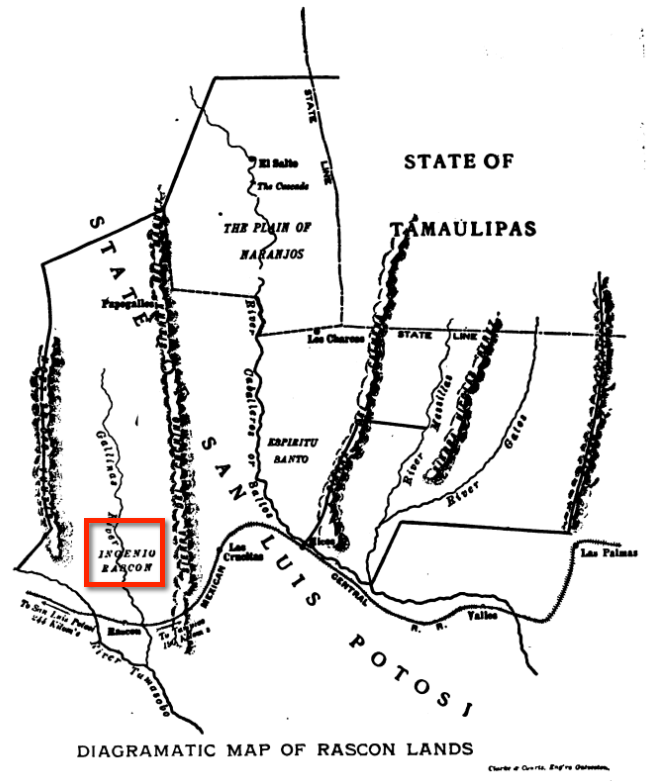
“The Ancient Hacienda of San Ignacio del Buey,” The Louisiana Planter and Sugar Manufacturer, XXXVII (25 April 1906) 123; image copy, HathiTrust Digital Library (https://www.hathitrust.org/ : accessed 7 September 2017).
The Rascon lands were described at this time as abundant farmlands, with renters, and with rich pastures for raising cattle and horses.5
“The principal hacienda, in that it has been developed more largely than the others, is the Yngenio Rascon, upon which is Rascon Station. This place has an acreage of about 25,000, of which more than 5,000 is irrigable land of the character already described…It has a complete sugar mill of 200 tons capacity, situated at the headquarters of the hacienda about nine miles from Rascon station…There are on this place, at the present time, over a thousand acres in cultivation for the hacienda, and in addition a large acreage farmed by renters…On this place is a handsome owner’s residence, the houses of the administrator and various other employees, store, warehouses, granaries, chapel, etc.”6
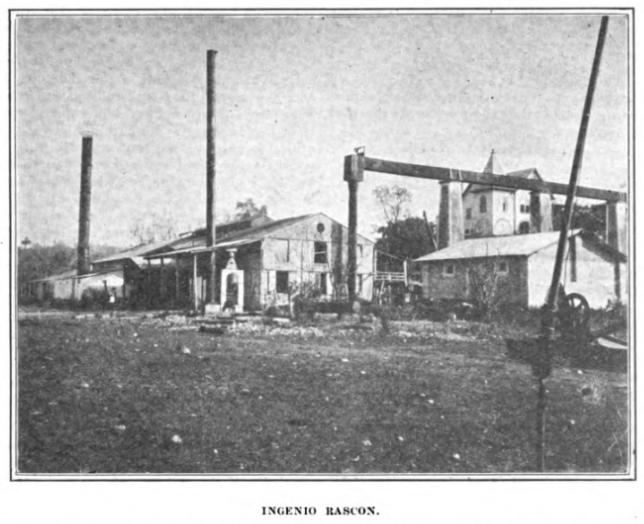
“The Ancient Hacienda of San Ignacio del Buey,” The Louisiana Planter and Sugar Manufacturer, XXXVII (25 April 1906) 122; image copy, HathiTrust Digital Library (https://www.hathitrust.org/ : accessed 7 September 2017).
Aunt Lupe’s birth record just tells us that her father was a farmer who lived at Yngenio Rasco.2 It does not tell us if he was hired to work with the sugar cane crops, or if worked on some of the other crops or with the livestock, or if he was one of those farmers or ranchers who rented land from the company. All of these are possibilities.
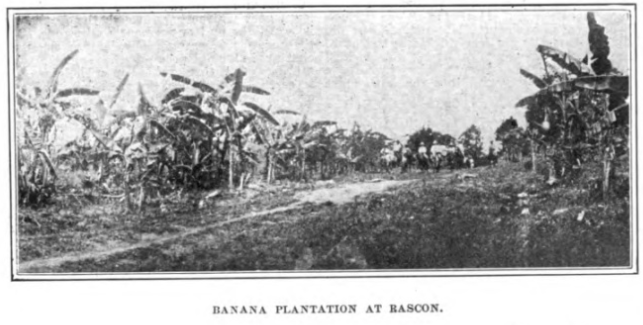
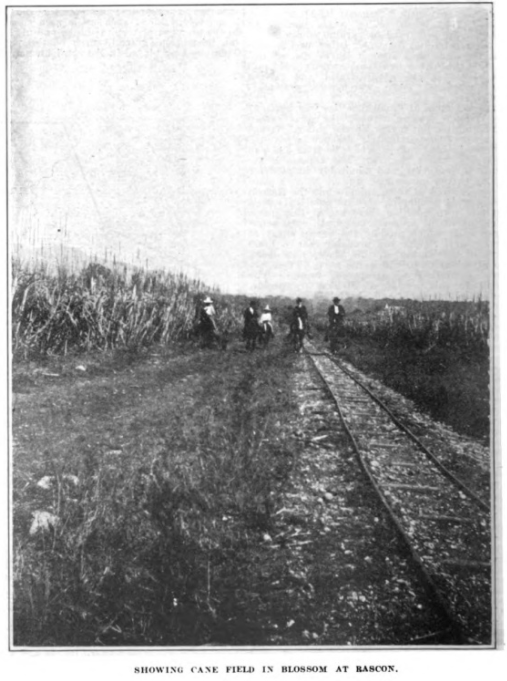
Remember my earlier statement about my great-grandmother Maria telling Dad she had contracted malaria back in Mexico? Malaria was a viable enough risk and worry at this time in tropical areas like Yngenio Rascon that a U.S. sugar industry trade magazine made a point of reporting the area as “demonstrated” to be free of malaria. “The section is singularly free from mosquitoes and files.”8
Did exploring Yngenio Rascon help me identify more ancestors for my family tree, or discover any new significant facts about my ancestors? No, but it has provided me with a bigger picture look at a short period in their lives.
Next Steps
Based on what I have learned from taking another look at this birth record and from my investigation into Yngenio Rasco, I have identified a few next steps to dig deeper into this era of my great-grandparents’ family history.
- I still have not located a baptism record for my great-aunt Lupe.
Because baptism is a Catholic sacrament that doctrine states affects one’s eternal salvation, Lupe’s parents likely would have baptized her shortly after birth. Most of the Mexico parish records are not yet indexed on FamilySearch, and consequently Ancestry (who gets this data from FamilySearch). Or if they have been indexed, those extracted index entries often are not yet linked to the actual digitized image. So searching for a baptism record on FamilySearch and Ancestry has not yet worked. However, the birth date and location specified in her civil birth registration should help me narrow down where to look (or browse) for Lupe’s baptism record. - I would like to know if any other family members moved with my great-grandparents to Yngenio Rascon.
Families historically did not move in isolation; they moved with other family or community members. Neither of the witnesses identified on Lupe’s birth record have surnames relevant to my family, but civil registration witnesses often were not related to the family. My best bet is to conduct searches for civil registrations in this same muncipio for other individuals with surnames common to José and Maria’s extended family group. - I am curious if any business records exist from this time period for Yngenio Rascon that might mention my family or just provide more context about their life during this time.
Since this was an American-owned company, these records stand a good chance (if they exist) of being held in by a U.S. Repository. I will start by looking at some of the larger archival record and archival finding aid portals, such as HathiTrust, NUCMC, DPLA, etc.
[contentblock id=49 img=html.png]
[contentblock id=2 img=html.png]
[contentblock id=3 img=html.png]
